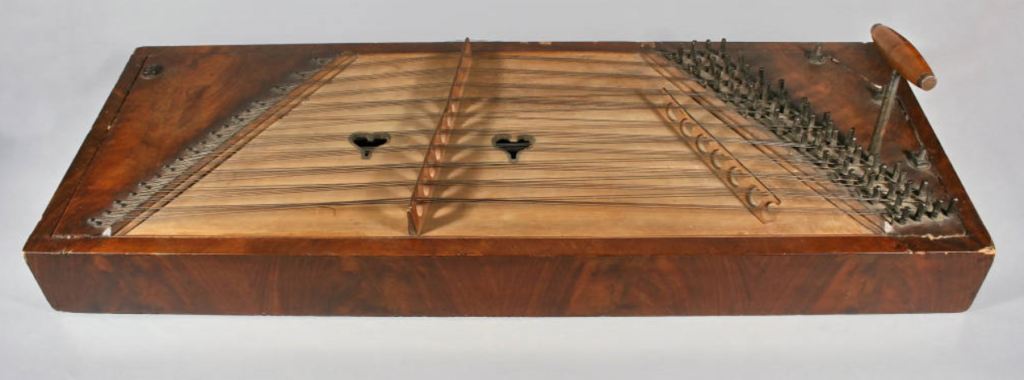Made in America with Foreign Parts
12 Hammered Dulcimer
 |
Hammered Dulcimer American Orrin Sweet, 1857-1858 Wood, metal Gift of Delma Donald Woodburn Estate MHAHS 2002.001.0147 |
A relative of the zither, the hammered dulcimer is a stringed percussion instrument with different names and styles and a history beginning in antiquity. This dulcimer was made by Orrin Sweet, a cabinet maker that moved from New York to the Midwest to build and sell dulcimers. In 1857, he lived in a log house on the Donald family farm and gave them this dulcimer as payment. While the Donald family children were young, Ellen Sweet Donald supposedly played the dulcimer at get togethers, while her brother James played second fiddle, and their sister Addie played melodeon.

Photograph of Ellen Donald Sweet playing the Dulcimer with her son John S. Donald
For a complete essay on this object, click here.
The hammered dulcimer is a type of stringed percussion instrument that has many different names and styles across the world. A relative of the zither, it has a long history dating back to antiquity. This hammered dulcimer follows the style that emerged in New York during the mid-nineteenth century. Manufacturers in Chautauqua, New York began mass producing the dulcimer style for a growing population interested in performing and entertaining friends and family. The dulcimer was ideal for immigrants, pioneers, and frontiersman moving westward because of its compact size and weight.
This dulcimer was made by Orrin Sweet, a cabinet maker that moved from New York to the Midwest to build and sell dulcimers. For a time, he lived in a log house on the Donald family farm and in 1857 he gave the family this dulcimer as payment for his lease. While they were young, Ellen Sweet Donald would play the dulcimer at gatherings. According to her brother James’s scrapbook, James played second fiddle, their sister Addie played melodeon, and Ellen accompanied on the Dulcimer.[3]
Dulcimers were favored alongside popular instruments such as the fiddle because they did not require a great deal of musical knowledge. In fact, most dulcimer players played “by ear” with no set written music. [1] Since the dulcimer did not have a standard set of music, it developed very distinct regional playing styles. When music and styles were shared, they were passed by word of mouth rather than being officially documented. Over time, an improvisational style called “chording” developed in the Great Lakes region. [2]
Around the time of the Civil War, the Dulcimer began to fall out of use. Firstly, people didn’t move around as much. Wisconsin and the greater Midwest started to become more permanently settled. Secondly, since the region was developing so rapidly, it became more feasible to own a piano, both financially and logistically. Finally, the quality that made the dulcimer so popular initially, its appeal to novice players and regionality, impaired the survival of the dulcimer to future generations. Since the older generation didn’t possess shared songs with written music, the next generation didn’t have any documents to guide them.
Overall, the dulcimer represents the central role music played in the lives of Wisconsin’s mid-nineteenth century settlers. It was an important source of entertainment for people living in small farming communities. Moreover, it might even be said that instruments such as the dulcimer were fodder for building new communities. For new communities are built from more than wood and stone; they are also built from the relationships of the community members. As self-reliant as the pioneers were, they relied upon one another in forging their new territory. Music, especially music that anyone could play, provided a platform for community members to gather, enjoy one another’s company, and share their lived regional experience.
References

